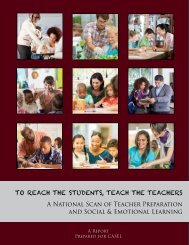Future Ready Learning
7m3sdJ
7m3sdJ
You also want an ePaper? Increase the reach of your titles
YUMPU automatically turns print PDFs into web optimized ePapers that Google loves.
The district routinely evaluates the user experience of the openly licensed resources.<br />
Follow-up efforts will encourage the district’s most innovative teachers to remix or<br />
contribute original openly licensed learning resources, leveraging the Illinois Shared<br />
<strong>Learning</strong> Environment OER tool set to do so.<br />
Partner With Other Organizations<br />
Partnership options for securing resources include local businesses and other organizations,<br />
alumni, internal and nearby teacher experts to provide professional development, and curriculum<br />
development arrangements with other districts. Some school districts have formed partnerships<br />
with local and county governments, sharing technology infrastructure and technical staff<br />
to keep costs down by jointly funding chief technology officer roles and taking advantage of<br />
the economies of scale when building and purchasing broadband access together. These economies<br />
of scale also can be realized through consortium purchasing such as the Kentucky Valley<br />
Educational Cooperative, which represents several districts and higher education institutions at<br />
once and helps decide issues of resource allocation.<br />
Make Full Use of Federal Funds<br />
The E-rate program provides substantial price discounts for infrastructure costs for schools and<br />
public libraries and is one source of technology funding. In addition, for funding beyond connectivity,<br />
a U.S. Department of Education Dear Colleague letter, published in November 2014,<br />
provides guidance and examples for leveraging existing federal funds for technology-related<br />
expenditures.<br />
USING FEDERAL FUNDS: U.S. DEPARTMENT OF EDUCATION DEAR COLLEAGUE<br />
LETTER ON ACCEPTABLE USES OF FEDERAL FUNDING FOR TECHNOLOGY<br />
The purpose of the Dear Colleague letter prepared by the U.S. Department of<br />
Education in November 2014 was to help state, district, and eligible partnership<br />
grantees better understand how they may be able to use their federal grant funds to<br />
support innovative technology-based strategies to personalize learning. The letter<br />
includes examples of how funds from the Elementary and Secondary Education Act<br />
(Titles I, II, and III) and Individuals with Disabilities Education Act (IDEA) may support<br />
the use of technology to improve instruction and student outcomes. Examples were<br />
limited to the Elementary and Secondary Education Act and IDEA because of the<br />
scale of these programs, but funds from many other formula and competitive grant<br />
programs that are administered by the U.S. Department of Education also may be used<br />
for this purpose.<br />
The examples do not depart from previous U.S. Department of Education guidance<br />
but rather clarify opportunities to use federal grant funds to support digital learning,<br />
including improving and personalizing professional learning and other supports for<br />
educators, increasing access to high-quality digital content and resources for students,<br />
facilitating educator collaboration and communication, and providing devices for<br />
students to access digital learning resources. Funding these four areas is important<br />
because technology itself is not a panacea.<br />
OFFICE OF Educational Technology<br />
46



